
Regina's historic buildings and precincts
Encyclopedia
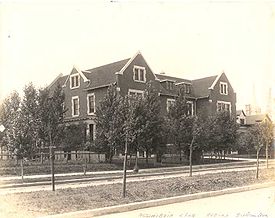
Regina, Saskatchewan
Regina is the capital city of the Canadian province of Saskatchewan. The city is the second-largest in the province and a cultural and commercial centre for southern Saskatchewan. It is governed by Regina City Council. Regina is the cathedral city of the Roman Catholic and Romanian Orthodox...
were lost during the period 1945 through approximately 1970 when the urge to "modernize" overtook developers' and city planners' sense of history and heritage. The old warehouse district to the north of the old CPR tracks was Regina's original commercial raison d'être once Lieutenant-Governor Edgar Dewdney
Edgar Dewdney
Edgar Dewdney, PC was a Canadian politician born in Devonshire, England. He served as Lieutenant Governor of the North-West Territories and the fifth Lieutenant Governor of British Columbia.-Early life and career:...
had established the site of his considerable landholdings as the site of his Territorial Capital. With latter-day eclipse of the railways in favour of highway trucking, the Warehouse District has lost its original purpose. In recent years the Warehouse District has incrementally been transformed into an interesting shopping and residential precinct.
The Assiniboia Club on Victoria Avenue has long since ceased to be an élite men's club and continues in use as a restaurant; the former Anglican Diocesan property is now being intelligently developed along commercial lines with the historic buildings jealously retained. Significant historic buildings and precincts include the following.
Federal
The Old Post OfficePrince Edward Building (Regina)
The Prince Edward Building is the current official name of the historic post office building in Regina, Saskatchewan, located at the corner of Scarth Street and 11th Avenue. The site had been occupied by Knox Presbyterian Church until it was demolished.The post office was designed in the...
has now been converted to commercial and cultural use in connection with the ongoing revitalisation of downtown Scarth Street as a pedestrian mall and houses the Globe Theatre
Globe Theatre, Regina
The Globe Theatre in Regina, Saskatchewan, was founded in 1966 by Ken and Sue Kramer. It was the first professional educational theatre company and the only professional theatre company in Saskatchewan.-Background:...
. It was completed in 1907; its 1912 clock tower was for many years locally regarded as Regina’s Big Ben
Clock Tower, Palace of Westminster
Big Ben is the nickname for the great bell of the clock at the north end of the Palace of Westminster in London, and is generally extended to refer to the clock or the clock tower as well. It is the largest four-faced chiming clock and the third-tallest free-standing clock tower in the world...
. The building was replaced as a post office in 1956 by the current post office on Saskatchewan Drive (formerly South Railway Street).
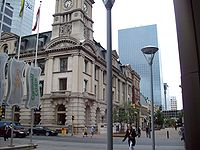
Hotel Saskatchewan
The Hotel Saskatchewan is a grand hotel located in downtown Regina, Saskatchewan, Canada, overlooking Victoria Park.One of a chain of hotels constructed and owned by the Canadian Pacific Railway, the railway's earlier hotels, such as the Château Frontenac in Quebec City, the Chateau Lake Louise and...
and the 1963 Saskatchewan Power Building, also on Victoria Avenue, were, with the Provincial Legislative Building and the spires of Holy Rosary Roman Catholic Cathedral, the only high-rise structures in the city and were visible from many miles' distance as one approached Regina by road from any direction.
Territorial
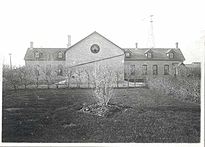
Government House
Government House (Saskatchewan)
Government House, Regina, Saskatchewan, was constructed as a residence for the Lieutenant-Governor of the North-West Territories, whose territorial headquarters were in Regina until the provinces of Saskatchewan and Alberta were created out of the Territories in 1905 and Regina became the capital...
on Dewdney Avenue was completed in 1891 as the vice-regal residence for the Lieutenant-Governor of the North-West Territories, replacing the first Government House on the present site of Luther College
Luther College (Saskatchewan)
Luther College is a college and high school located in Regina, Saskatchewan, Canada. The university portion of Luther College is located on the campus of the University of Regina and is a federated college. The high school is located at a separate site in the McNab neighbourhood of Northwest Regina...
farther west on Dewdney Avenue. It was the first electrified residence in the Territories and remained the residence of the Lieutenant-Governor of the North-West (later Northwest) Territories and, after the creation of the province of Saskatchewan, of the province until 1945; latterly, with increasing historical sensibility among the general public, it has been restored to its former use as a vice-regal mansion, albeit only for public functions and not as a residence per se.
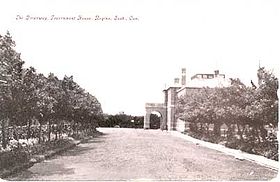
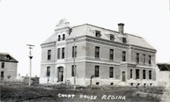
Provincial
The Beaux-Arts Saskatchewan Legislative BuildingSaskatchewan Legislative Building
The Saskatchewan Legislative Building is located in Regina, Saskatchewan, Canada, and houses the Legislative Assembly of Saskatchewan.-History:...
on the south shore of Wascana Lake was constructed 1908-12. The design contemplates expansion of the building by the addition of wings extending south from the east and west ends and coming together to form a courtyard. The plans originally called for the exterior of the building to be red brick but after construction had begun and red bricks were already on the site, Premier Walter Scott insisted on Manitoba tyndall stone being substituted. It immediately became and remains the dominating architectural presence in Regina.
Civic

It temporarily relocated for some years to the considerably smaller Beaux-Arts old Post Office building on Scarth and 11th Avenue which had been left standing and essentially without purpose after the construction of the new Post Office on South Railway Street (now Saskatchewan Drive) after the demolition of the 1908 building, and this saved the old Post Office—now containing the stage of the professional Globe Theatre
Globe Theatre, Regina
The Globe Theatre in Regina, Saskatchewan, was founded in 1966 by Ken and Sue Kramer. It was the first professional educational theatre company and the only professional theatre company in Saskatchewan.-Background:...
—from the wrecker’s ball.
City Hall was ultimately moved in 1976 from the Old Post Office building to a modern office block in the style of the original University of Regina buildings at the new campus, on the western periphery of the city centre on Victoria Avenue, opposite from the Courthouse and across 12th Avenue from St Paul's Anglican Cathedral.
Historic private schools
_and_broad_street,_1913._building_under_construction..jpg)
University of Regina
The University of Regina is a public research university located in Regina, Saskatchewan, Canada. Founded in 1911 as a private denominational high school of the Methodist Church of Canada, it began an association with the University of Saskatchewan as a junior college in 1925, and was disaffiliated...
, originally a private residential high school and junior college, was established by the Methodist Church of Canada
Methodist Church of Canada
The Methodist Church of Canada was a united church formed in 1884 and comprising most former Methodist denominations in Canada including some that had been active along Canada's eastern coast and north of the St...
in 1913 in response to the award of the University of Saskatchewan to Saskatoon
Saskatoon
Saskatoon is a city in central Saskatchewan, Canada, on the South Saskatchewan River. Residents of the city of Saskatoon are called Saskatonians. The city is surrounded by the Rural Municipality of Corman Park No. 344....
rather than Regina. It became affiliated with the University of Saskatchewan in the 1920s, was disaffiliated with the United Church in the 1930s and ceased offering high school classes; it is now the University of Regina.

The Roman Catholic Jesuit Order operated Campion
Edmund Campion
Saint Edmund Campion, S.J. was an English Roman Catholic martyr and Jesuit priest. While conducting an underground ministry in officially Protestant England, Campion was arrested by priest hunters. Convicted of high treason by a kangaroo court, he was hanged, drawn and quartered at Tyburn...
College, originally a high school with junior college accreditation with the University of Saskatchewan like Regina College, on 23rd Avenue; the Sisters of Our Lady of the Missions operated Sacred Heart College, later Marian High School, to the south of Campion College on Albert Street and Sacred Heart Academy in the West End immediately adjacent to Holy Rosary Cathedral. All are now closed, though the Campion and Sacred Heart Academy buildings survive with new uses: Campion as a conservative Evangelical Protestant religious school; Sacred Heart Academy as residential condominiums.
The Evangelical Lutheran Church in Canada
Evangelical Lutheran Church in Canada
The Evangelical Lutheran Church in Canada is Canada's largest Lutheran denomination, with 152,788 baptized members in 624 congregations, with the second largest, the Lutheran Church–Canada, having 72,116 baptized members...
's Luther College, on the site of the original Government House next to the RCMP Academy, Depot Division
RCMP Academy, Depot Division
RCMP Academy, Depot Division has been providing police training to Royal Canadian Mounted Police "cadets" since its establishment in 1885. The facility is located in the west part of Regina, Saskatchewan, near the airport, and consists of several buildings.In the RCMP's early days, Depot had a...
, is the one remaining historic private school in Regina. Campion College no longer operates a high school but is now a federated college at the University of Regina, as is Luther College.
Theatres and concert halls
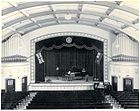
London
London is the capital city of :England and the :United Kingdom, the largest metropolitan area in the United Kingdom, and the largest urban zone in the European Union by most measures. Located on the River Thames, London has been a major settlement for two millennia, its history going back to its...
, New York
New York
New York is a state in the Northeastern region of the United States. It is the nation's third most populous state. New York is bordered by New Jersey and Pennsylvania to the south, and by Connecticut, Massachusetts and Vermont to the east...
, Sydney
Sydney
Sydney is the most populous city in Australia and the state capital of New South Wales. Sydney is located on Australia's south-east coast of the Tasman Sea. As of June 2010, the greater metropolitan area had an approximate population of 4.6 million people...
and Brisbane
Brisbane
Brisbane is the capital and most populous city in the Australian state of Queensland and the third most populous city in Australia. Brisbane's metropolitan area has a population of over 2 million, and the South East Queensland urban conurbation, centred around Brisbane, encompasses a population of...
, contained a large central theatre and concert hall-cum-ballroom.
Darke Hall, a civic theatre and concert hall adjacent to Regina College, was donated by Francis Nicholson Darke
Francis Nicholson Darke
Francis Nicholson Darke was a leading citizen of Regina, Saskatchewan and served as Mayor of Regina, Member of Parliament and as a prominent businessman....
. Mr Darke also donated the carillon of chimes to the then-Methodist, now United Church of Canada
United Church of Canada
The United Church of Canada is a Protestant Christian denomination in Canada. It is the largest Protestant church and, after the Roman Catholic Church, the second-largest Christian church in Canada...
Metropolitan Church in downtown Regina which is still heard.
Darke Hall was for many years Regina’s principal concert hall and theatre, particularly after
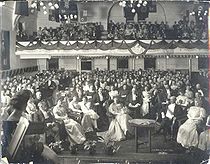
the destruction by fire in 1939 of the 800-seat Regina Theatre on the corner of 12th Avenue and Hamilton (now the site of the old Hudson's Bay Company
Hudson's Bay Company
The Hudson's Bay Company , abbreviated HBC, or "The Bay" is the oldest commercial corporation in North America and one of the oldest in the world. A fur trading business for much of its existence, today Hudson's Bay Company owns and operates retail stores throughout Canada...
department store building) — home from 1910 to the Regina Operatic Society, the Regina Orchestral Society and travelling vaudeville and stage plays — and
the demolition of Old City Hall in 1965, whose ballroom had provided a multi-purpose space used for civic receptions, concerts, theatre, balls and indeed boxing.
Darke Hall opened in 1929. It remains the recital and concert hall for the Regina Conservatory of Music and the University of Regina's Department of Music as well as the venue for amateur theatricals and public lectures.
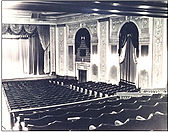
By the 1980s, Famous Players, which had acquired the Capitol, by now the last historic legitimate theatre and even cinema in the central business district (the Grand, the Rex, the Broadway, the Roxie and the Met had closed by the end of the 1981), was in financial trouble and desperately divided the Cap in half to make a poor-man's multiplex; ultimately the Cap itself was closed. By the time of its demolition in 1992 it was the last of many downtown movie theatres which had once thrived — the Regina Theatre, the Rex, the Grand, the Unique, the Roseland, the Elite, the Princess, the Lux, the Gaiety, the Broadway, the Roxy, the 1000-seat Metropolitan and the Cap itself. An office tower now occupies the site; the old Hudson's Bay Department store building, on the site of the Regina Theatre, is now also occupied by offices.
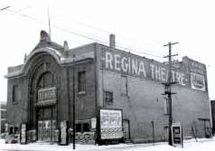
University of Regina
The University of Regina is a public research university located in Regina, Saskatchewan, Canada. Founded in 1911 as a private denominational high school of the Methodist Church of Canada, it began an association with the University of Saskatchewan as a junior college in 1925, and was disaffiliated...
and well outside the Regina Central Business District, both highbrow and mainstream entertainment were comprehensively removed from the city centre, completing the process begun with the destruction of the Regina Theatre and the demolition of Old City Hall. The Globe Theatre has moved downtown from the Centre of the Arts into the Old Post Office building, and nowadays is the only entertainment venue in the city centre apart from the Casino Royale in the former CPR Union train station , and city planners seeking to revitalise the downtown business district must contend with the consequences of decisions by predecessors who directed the city's entertainment facilities away from the city centre.
Carnegie Library
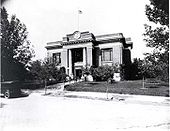
Regina Public Library
Regina Public Library is a city-wide library system spread throughout nine locations that serves the citizens of Regina, Saskatchewan by providing an open and accessible environment where anyone can access information for work, study, and recreation...
, built as in many cities of North America and the United Kingdom with a grant from the Carnegie Foundation, was destroyed in the 1912 Regina "Cyclone"
Regina Cyclone
The Regina Cyclone is the popular name for a tornado that devastated the city of Regina, Saskatchewan, Canada on June 30, 1912. At about 4:50 p.m., green funnel clouds formed and touched down south of the city, tearing a swath through the residential area between Wascana Lake and Victoria Avenue...
but quickly rebuilt with the help of a further Carnegie grant. It was demolished and replaced in 1962 by an impressively large though architecturally undistinguished building on the same site at Lorne Street and 12th Avenue which, like the Court of Appeal and Queens Bench building on Victoria Avenue, preserves remnants of its predecessor in its forecourt.
The institution of amply-endowed public libraries became well established in Regina and Regina burgesses quickly became inured to the idea of such facilities being worthwhile public facilities and worthy of substantial public endowment. Latterly the Regina City Council has sought to cut costs by proposing to close neighbourhood libraries, including the Connaught Library in the West End (latterly dubbed the "Cathedral Area"), to general public condemnation.
Germantown proper

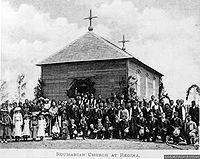
German, Ukrainian, Romanian and Serbian religious, secular and educational institutions and services were early established in the neighbourhood — including St Nicholas's Romanian Orthodox Church (established in 1902), the oldest Romanian Orthodox parish in North America; St George's Cathedral (founded in 1914 though the present building dates from the early 1960s), the episcopal seat of the Romanian Orthodox Bishop of Regina; and the now long-demolished Holy Trinity Serbian Orthodox Church and the Ukrainian Orthodox
Ukrainian Orthodox Church of Canada
The Ukrainian Orthodox Church of Canada is an Eastern Orthodox Church in Canada, primarily serving Ukrainian Canadians. Its former name was the Ukrainian Greek Orthodox Church of Canada ...
Church of the Descent of the Holy Ghost, both formerly on Winnipeg Street. Beth Jacob Synagogue
Synagogue
A synagogue is a Jewish house of prayer. This use of the Greek term synagogue originates in the Septuagint where it sometimes translates the Hebrew word for assembly, kahal...
, originally established in 1905 and now re-located to South Regina, was originally also in Germantown on Victoria Avenue at Osler Street, immediately to the east of Broad Street Park (since the 1960s occupied by a shopping mall and the Regina Inn).

Regina's Anglo-Saxon élite grievously neglected Germantown in the early days and basic services of water and sewerage came scandalously late to the precinct. Many residents of the Germantown quarter of Regina lived in squalid shacks without basic services till well into the 20th century, when issues of loyalty to the British Crown during the First World War were comprehensively resolved in the favour of the residents' complete Canadian-ness. By the 1960s invidious past ethnic prejudice had long since passed and Ukrainian food had become pan-prairie cuisine, with sour cabbage and frozen perogies amply available in Regina supermarkets. Apart from German Lutheran and Roman Catholic establishments throughout Regina, however, European churches and cultural clubs remain concentrated in Germantown.

Evangelical Lutheran Church in Canada
The Evangelical Lutheran Church in Canada is Canada's largest Lutheran denomination, with 152,788 baptized members in 624 congregations, with the second largest, the Lutheran Church–Canada, having 72,116 baptized members...
— now occupying a large but undistinguished A-frame building on Ottawa Street in the heart of Germantown — remains the centre of Regina's Lutheran constituency, though Canadian Lutheranism, while maintaining the historic episcopacy and indeed being in full communion with the Anglican Church of Canada, does not designate metropolitan churches as cathedrals. Trinity for many years maintained a traditional German parish church in Germantown; in due course, when it had built its new modern building, it sold its impressive German pipe organ to an Anglican parish church.
At the southern periphery of Germantown is an Anglo-Saxon-Celtic neighbourhood. St Matthew's Anglican Church remains on 14th Avenue and Winnipeg Street ; Carmichael United Church on 13th Avenue immediately adjacent to Regina General Hospital, built in 1920 as Carmichael Presbyterian and later together with the neighbouring Wesley Methodist Church becoming a congregation of United Church, closed in 1996. Its chancel furniture was acquired by the University of Regina for use at convocation ceremonies, a little-noted historic link with the university's origins as a United Church denominational college.
The Qu'Appelle diocesan property

Qu'Appelle, Saskatchewan
Qu'Appelle, Saskatchewan, is a small village and formerly in ecclesiastical terms a city, with considerable historic significance located on Trans-Canada Highway and the Canadian Pacific Railway mainline, some east of the provincial capital of Regina.Qu'Appelle was for a time the terminus of the...
had been passed over as the metropole for the new District of Assiniboia
Assiniboia
Assiniboia refers to a number of different locations and administrative jurisdictions in Canada. The name is taken from the Assiniboine First Nation.- District of Assiniboia:...
and Province of Saskatchewan and that Regina would be the principal city of southern Saskatchewan the Diocese relocated its headquarters. The once-mooted Anglican cathedral is outlined in caragana hedges diagonally at the corner of Broad Street and College Avenue.
The property was sold to the provincial crown in the 1970s by way of finally obtaining fiscal self-reliance: the Anglican Diocese of Qu'Appelle was originally a mission field of the English Diocese of Lichfield and this was increasingly anomalous. For a time the Diocese leased back the property; it has now been sold for commercial and residential redevelopment; the current Regina Development plan mandates that it be "[ensured] that new development allows for views into the site from Broad Street to significant heritage features, especially the tower of St. Chad’s."
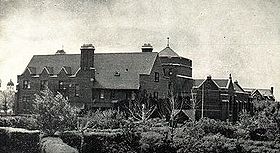
Qu'Appelle
Qu'Appelle may refer to:* Chateau Qu'Appelle, hotel* CSTC HMCS Qu'Appelle, Cadet Summer Training Centre HMCS* Diocese of Qu'Appelle, diocese of the Anglican Church of Canada* Fort Qu'Appelle, Saskatchewan* HMCS Qu'Appelle...
Diocesan School (whose premises were originally a theological seminary for the training of clergy) and Anglican nunnery (with the historic St Chad's Chapel), diocesan administrative buildings, an old people's home and the bishop's palace. The property had been acquired by the Church of England (as it then was) when it became apparent that the original see "city" of Qu'Appelle had been passed over as the metropole for the new District of Assiniboia
Assiniboia
Assiniboia refers to a number of different locations and administrative jurisdictions in Canada. The name is taken from the Assiniboine First Nation.- District of Assiniboia:...
and Province of Saskatchewan.
The site of the once-mooted but never-begun Anglican cathedral is outlined in caragana hedges diagonally at the corner of Broad Street and College Avenue. Qu'Appelle Diocesan School promotional brochures referred to the entire diocesan land and premises as "the Cathedral property." The original grand scheme of building a Regina cathedral on the Qu'Appelle Diocesan property was comprensively abandoned in 1974 when the modest downtown parish church of St Paul's (the pro-cathedral since 1944) was designated the cathedral of the Qu'Appelle Diocese. The Anglican Church of Canada is presently considering a regrouping of its ecclesial structure and the future cathedral status of St Pauls and the diocesan status of the former District of Assiniboia as the Diocese of Qu'Appelle may well be in doubt as the church deliberates over its increasingly top-heavy structure. The Institute for stained glass in Canada has documented the stained glass at St Paul's Anglican Cathedral
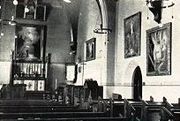
The specific planning considerations for this site [include]: To support the preservation of significant heritage buildings on the site where feasible, and to ensure they remain as viable as possible….To ensure a new development that is sympathetic to the style of the heritage….To provide landscaped open areas which are conducive to pedestrian use and enjoyment and that will provide focal points for vistas to significant aspects of the site, such as to specific heritage features….To ensure that building height and massing surrounding the heritage buildings…does not overpower the existing heritage buildings and that the heritage buildings maintain their prominence….To ensure that new development allows for views into the site from Broad Street to significant heritage features, especially the tower of St. Chad’s….[And] [t]o ensure that architectural styles and materials used in the construction of new building façades and roofs are complementary to the original buildings.
The warehouse district

Canadian Pacific Railway
The Canadian Pacific Railway , formerly also known as CP Rail between 1968 and 1996, is a historic Canadian Class I railway founded in 1881 and now operated by Canadian Pacific Railway Limited, which began operations as legal owner in a corporate restructuring in 2001...
rail line, is the warehouse district. Before the highways were upgraded to the extent that they permitted trans-Canada commercial shipping by road within Canada, and did not require trucking companies to dip below the 49th parallel to traverse the Great Lakes, the railways knit the country together. In particular the mail-order companies of Eaton's
Eaton's
The T. Eaton Co. Limited was once Canada's largest department store retailer. It was founded in 1869 in Toronto by Timothy Eaton, an Irish immigrant. Eaton's grew to become a retail and social institution in Canada, with stores across the country, buying offices across the globe, and a catalogue...
and Robert Simpson enabled inhabitants of now-defunct rural communities to shop by post.
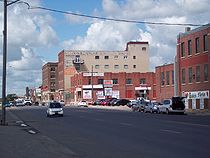
Downtown and West End ("Cathedral Area") churches
First Baptist Church on the corner of Victoria Avenue and Lorne Street, was opened in 1911 and its gold organ pipes first heard in 1912. The church was renowned for its large domed ceiling and chandelier. The Institute for stained glass in Canada has documented the stained glass at First Baptist Church. The 1912 Regina "Cyclone"Regina Cyclone
The Regina Cyclone is the popular name for a tornado that devastated the city of Regina, Saskatchewan, Canada on June 30, 1912. At about 4:50 p.m., green funnel clouds formed and touched down south of the city, tearing a swath through the residential area between Wascana Lake and Victoria Avenue...
severely damaged the church but it was soon restored. Unlike other imposing church buildings in downtown Regina and the East End, First Baptist survives as a major landmark.
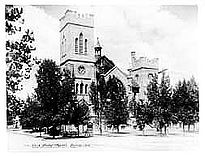
United Church of Canada
The United Church of Canada is a Protestant Christian denomination in Canada. It is the largest Protestant church and, after the Roman Catholic Church, the second-largest Christian church in Canada...
merged and occupied the Metropolitan building with Knox being demolished. Many of Knox's congregation had dissented from the 1925 church union and adjourned to the new First (non-concurring) Presbyterian Church on Albert Street, built in 1926; more members of Knox's congregation had relocated to the new post-World War II residential subdivision of Lakeview and when Knox United was demolished its impressive pipe organ was moved to Lakeview United Church. Knox-Met is the major venue for downtown choral concerts, organ recitals and the annual Kiwanis
Kiwanis
Kiwanis International is an international, coeducational service club founded in 1915. It is headquartered in Indianapolis, Indiana. Current membership is 240,000 members in 7,700 clubs in 80 nations...
Carol Festival. Like First Baptist and Westminster United, Knox-Met has its interior arranged in the Akron Plan
Akron Plan
Akron Plan for church buildings was popularized by architectural pattern books in the late 19th and early 20th century. The plan is typified by an auditorium form worship space surrounded by connecting Sunday school classrooms spaces on one or two levels. The plan promotes efficiency of movement...
, a square auditorium the pews arranged in a fan shape radiating out from the pulpit and portable communion table, making it ideal for such uses. The Darke Memorial Chimes are heard every Sunday morning and on other special occasions. The church has a large 3-manual Casavant Frères
Casavant Frères
Casavant Frères is a prominent Canadian company in Saint-Hyacinthe, Quebec, which has been building fine pipe organs since 1879. As of 2008, they have produced over 3800 organs.- Company history :...
organ, the gift of Isabel Willoughby. Carmichael United Church in the East End, on the periphery of the central business district, was a congregation formed out of the previous Wesley Methodist and Carmichael Presbyterian churches in the immediate vicinity. Once one of Regina's most vibrant United Church congregations and the first church to have its services broadcast by radio, it was demolished in 1996. It had a substantial Casavant Frères
Casavant Frères
Casavant Frères is a prominent Canadian company in Saint-Hyacinthe, Quebec, which has been building fine pipe organs since 1879. As of 2008, they have produced over 3800 organs.- Company history :...
organ and fine chancel furniture which has now been resumed by the originally United Church-affiliated University of Regina
University of Regina
The University of Regina is a public research university located in Regina, Saskatchewan, Canada. Founded in 1911 as a private denominational high school of the Methodist Church of Canada, it began an association with the University of Saskatchewan as a junior college in 1925, and was disaffiliated...
for use in convocation ceremonies.
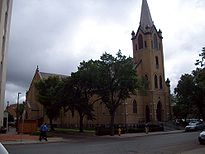

St. Paul's Cathedral (Regina)
St Paul's Anglican Cathedral is an historic church building located on the outskirts of Regina's central business district. Built as a parish church in 1894-1895, it became the pro-cathedral of the Anglican Diocese of Qu'Appelle, in southern Saskatchewan, Canada in 1944 when pro-cathedral status...
, built in 1894 and the oldest church building in the city still in use, is a modest parish church on the periphery of the central business district whose parish dates from 1883. It has been the designated cathedral church of the Anglican Diocese of Qu'Appelle
Anglican Diocese of Qu'Appelle
The Diocese of Qu’Appelle in the Anglican Church of Canada lies in the southern third of the civil province of Saskatchewan and contains within its geographical boundaries some 50% of the province's population of one million.-History:...
, comprising most of Southern Saskatchewan, since 1944 when it supplanted the original pro-cathedral of St Peter's in the eponymous town of Qu'Appelle
Qu'Appelle
Qu'Appelle may refer to:* Chateau Qu'Appelle, hotel* CSTC HMCS Qu'Appelle, Cadet Summer Training Centre HMCS* Diocese of Qu'Appelle, diocese of the Anglican Church of Canada* Fort Qu'Appelle, Saskatchewan* HMCS Qu'Appelle...
; its future cathedral status, however, is somewhat in doubt as the Anglican Church of Canada
Anglican Church of Canada
The Anglican Church of Canada is the Province of the Anglican Communion in Canada. The official French name is l'Église Anglicane du Canada. The ACC is the third largest church in Canada after the Roman Catholic Church and the United Church of Canada, consisting of 800,000 registered members...
considers rationalising its increasingly top-heavy episcopal structure.
First Presbyterian Church
Presbyterian Church in Canada
The Presbyterian Church in Canada is the name of a Protestant Christian church, of presbyterian and reformed theology and polity, serving in Canada under this name since 1875, although the United Church of Canada claimed the right to the name from 1925 to 1939...
on Albert Street was built in 1926 by non-concurring dissidents from the various Presbyterian congregations in the city of Regina — notably from Knox United, led by Judge W.M. Martin, and from Westminster United — which had universally opted to enter the United Church of Canada
United Church of Canada
The United Church of Canada is a Protestant Christian denomination in Canada. It is the largest Protestant church and, after the Roman Catholic Church, the second-largest Christian church in Canada...
in 1925. They built a fine, determinedly traditional church structure — with chancel, transepts and nave, as distinct from the Akron plan of Knox, Metropolitan, Westminster and First Baptist with pews fanning out from a central pulpit backed by choir benches — which is much prized by musical and cultural groups in the city as an auditorium. The Institute for stained glass in Canada has documented the stained glass at First Presbyterian Church.
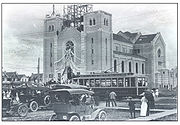
Holy Rosary Cathedral (Regina)
Holy Rosary Cathedral at 13th Avenue and Garnet Street in Regina, Saskatchewan, is the cathedral church of the Roman Catholic Archdiocese of Regina...
, a grand neo-romanesque structure on 13th Avenue in the West End, was completed in 1912 and consecrated in 1913; at the time, its 235-foot twin spires were the tallest structures in Regina. Its Casavant Frères
Casavant Frères
Casavant Frères is a prominent Canadian company in Saint-Hyacinthe, Quebec, which has been building fine pipe organs since 1879. As of 2008, they have produced over 3800 organs.- Company history :...
pipe organ, originally installed in 1930, repaired after a disastrous 1976 fire, and extensively refurbished and enlarged in 1992–1993, remains the largest organ in Regina. When it suffered its disastrous 1976 its congregation repaired next door to Westminster United, which gladly offered its worship space to Holy Rosary for the duration.
_church.jpg)
Neil R. Darrach
Neil R. Darrach was a noted Canadian architect from St. Thomas, Ontario. He was architect for over five designated heritage properties in St. Thomas, Ontario and Regina, Saskatchewan. He was primarily active in the later 19th century.-Early life:...
. Wascana Methodist, later United Church, a fine, elegant wooden structure in plain vernacular style on 13th Avenue at Pasqua, originally stood on 14th Avenue as Fourteenth Avenue Methodist Church, was moved in 1925 to its new site at 13th and Pasqua and later sold by its congregation when they built a new church in the West End; the congregation was subsequently dissolved and merged into Westminster. The West End, where the Cathedral is located, has acquired a somewhat bohemian air, and has in recent years increasingly attracted the sobriquet "the Cathedral Area."

RCMP Academy, Depot Division
RCMP Academy, Depot Division has been providing police training to Royal Canadian Mounted Police "cadets" since its establishment in 1885. The facility is located in the west part of Regina, Saskatchewan, near the airport, and consists of several buildings.In the RCMP's early days, Depot had a...
, across the CPR tracks and to the west of the "Cathedral Area" on Dewdney Avenue, dating from the earliest establishment of the then- North-West Mounted Police as a guardhouse in 1885. It subsequently served as a mess hall and canteen and became a chapel in 1895. At the time Lieutenant-Governor Edgar Dewdney designated Regina as the Territorial Headquarters for the North-West Territories the CPR had not yet reached Pile of Bones: the now-RCMP chapel, constructed in Ontario, was accordingly moved by flat-car, steamer and ox team to Regina.
The Mountie chapel is a favoured venue for RCMP weddings and funerals; most historic visitors to Regina have been taken to visit there and among the postcards on sale at the Mountie museum are photos of King George VI and Queen Elizabeth at the chapel during their 1939 tour of Canada and the USA when they visited virtually every town and city along the CPR and CNR lines garnering enthusiasm for the imperial connection in anticipation of the inevitable war with Germany. The RCMP (then the NWMP) barracks was where Louis Riel
Louis Riel
Louis David Riel was a Canadian politician, a founder of the province of Manitoba, and a political and spiritual leader of the Métis people of the Canadian prairies. He led two resistance movements against the Canadian government and its first post-Confederation Prime Minister, Sir John A....
was detained after his arrest in 1885 and ultimately hanged. The RCMP museum formerly contained a rather macabre display of the noose which hanged Riel though modern sensibilities have caused it to be retired from display.

